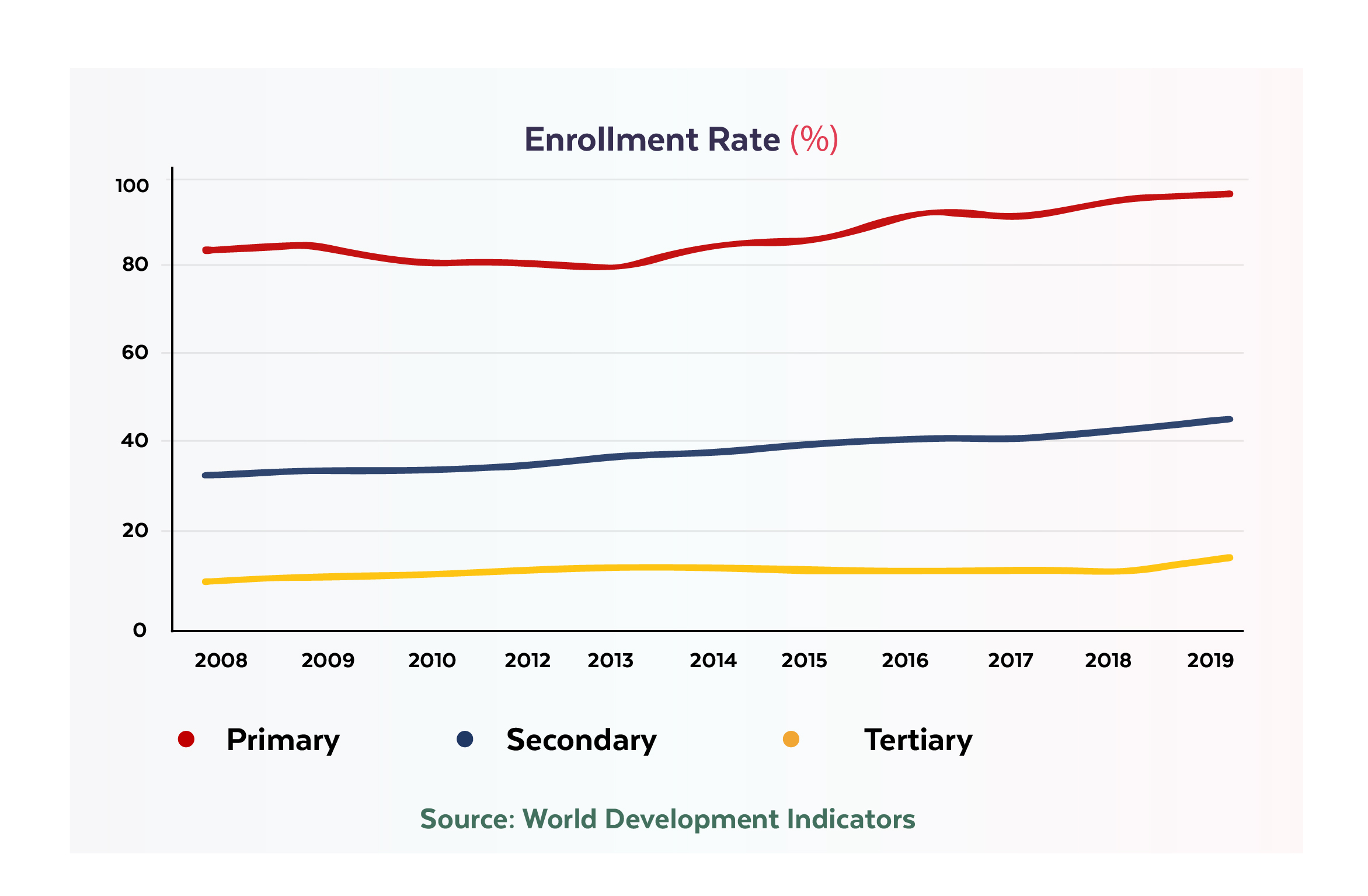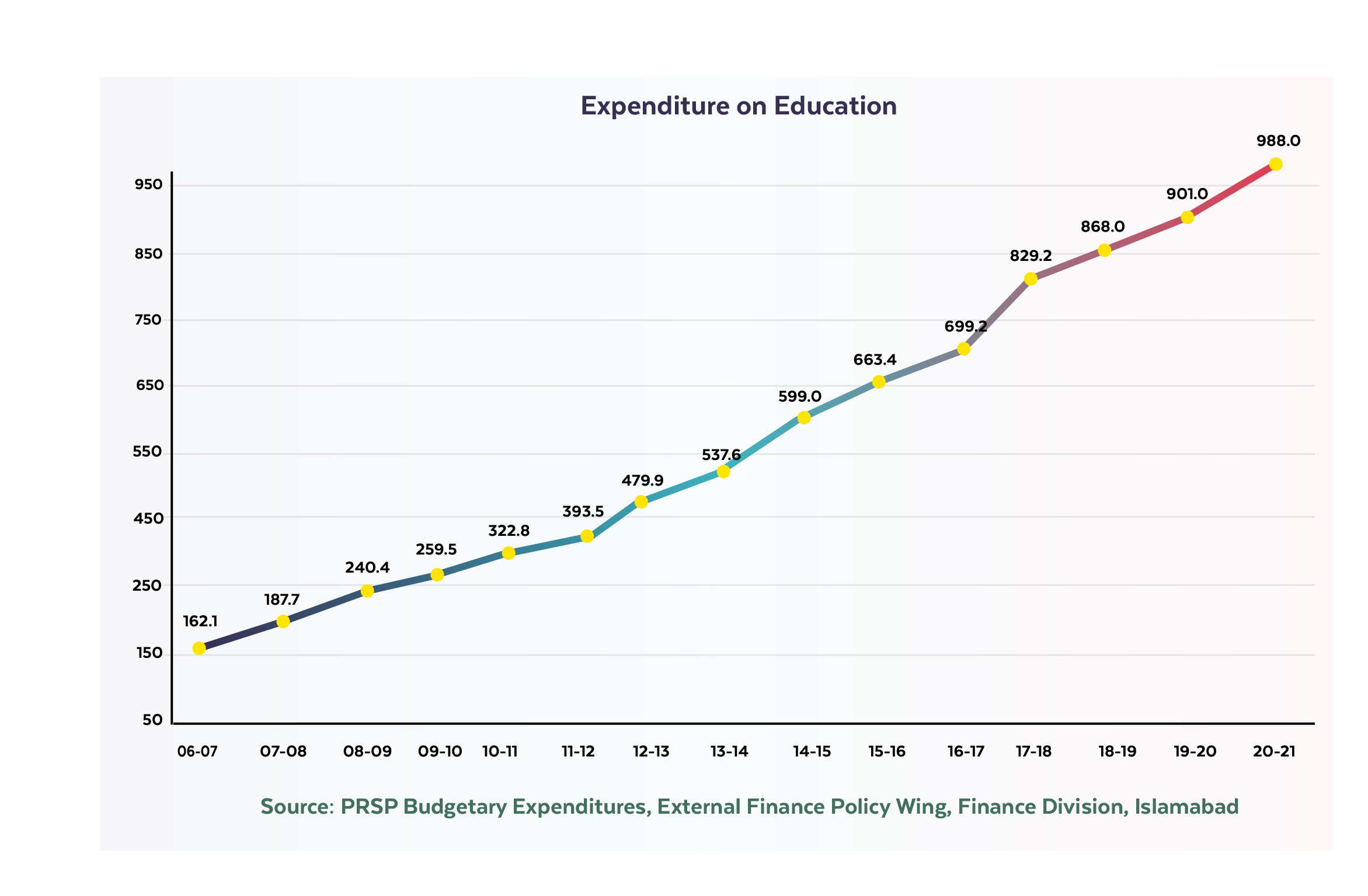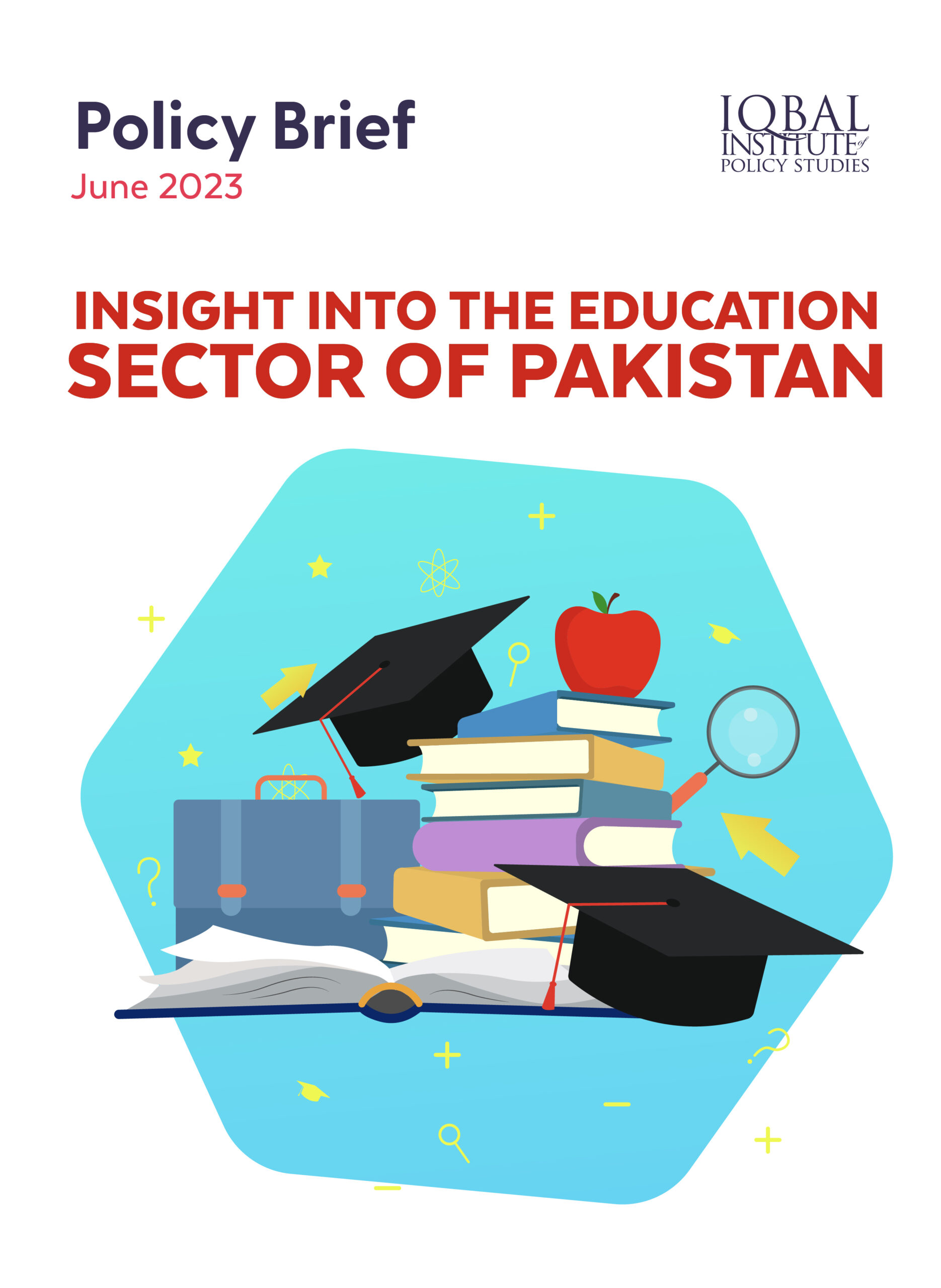Introduction
Education is the key driver of human capital formation. A country can achieve socioeconomic stability by investing in human capital and skill development programs. The government must support integrated human development, women empowerment, and equitable and universal quality education.
Education is essential for a prosperous and progressive society as it helps individuals to utilise their productive capabilities. Education empowers people to recognise and polish their potential. It is a weapon to encounter poverty and illiteracy and promote gender equality. This cannot be accomplished without adapting new skills and information required for sustainable development. The skills are evolving with the need of the job market. It was estimated that 50% of the employees need to reskill themselves by 2025 as technology adoption is increasing. World Economic Forum says problem-solving and critical thinking will be the top required skills in the next five years. To compete globally, Pakistan must develop high-quality education that helps produce a new-age skilled workforce.
Education is like an investment that fosters the nation’s future. Pakistan’s provincial and Federal governments are not paying attention to the education sector. The government has reserved only 2% of the budget for the educational sector, whereas India is investing 4.5% of its GDP. In other words, India is investing 3 times more in each student than Pakistan. There are 50 million children, and only half of them are enrolled. Pakistan has the second-highest out-of-school children, i.e., 22 million, because of poverty and poor quality of education. The inability and unwillingness of successive governments have increased the severity of educational sector problems at the primary, secondary, and tertiary levels. The education system faces several well-known problems, such as a lack of infrastructure, teachers, research and innovation, skilled faculty, ICT, critical thinking, and a uniform curriculum.
Pakistan is a signatory of the Sustainable Development Goals (SDG). Goal 4 aims to provide quality education, ensure inclusive and equitable quality education, and promote lifelong learning opportunities for everyone. The government has formed National Framework, yet it is not being implemented due to political inertia. Moreover, the classification budget as per the indicator of SDG 4 is essential; otherwise, it will be impractical for the government to keep track of progress (Khan, 2021). Only KP has initiated a gender-responsive budget to help address SDG 4.5, which states enhancing girls’ access to formal education. The government of Pakistan can implement SDG 4 if the Federal and Provincial governments align their targets in one direction, a budget must be adjusted in line with SDG 4, the introduction of a gender-responsive budget, hiring of subject specialist teachers (especially in Maths and science) and hire female teachers to encourage the parents to send their daughter to schools (Khan, 2021).
Current Snapshot
 Primary, Secondary, and Tertiary Education
Primary, Secondary, and Tertiary Education
Pakistan has three types of educational systems: private, public and Deeni Madaris. There are 305,763 educational institutes in Pakistan, accommodating 2,073,433 teachers and 51,186,560 students. Of these, 28.4 million are studying in public and 22.70 are in the Private sector. Comparatively, the teaching staff is higher in private schools (54%) than in public schools (46%). There are 61% primary, 21% middle, 17% higher and higher secondary institutions, whereas only 1% of universities are present in Pakistan. In tertiary education, Technical and Vocational Training holds the highest share of educational institutes, i.e., 67.5%, then Degree Colleges and lastly universities (3.8%). Though infrastructure-wise, universities lag behind, the enrollment rate is higher (64.2%), corresponding to TVET (15.6%). The graph shows that the enrollment rate is highest in a primary educational institute relative to secondary and tertiary. The Annual Status of Education Report (2021) has found that the total enrollment rate has declined from 86 to 84% due to pandemic-induced poverty. The overall youth literacy rate in Pakistan is 72%. However, out of it, 84% are in urban and 65% in rural areas.
Expenditure of Education
The major reason for low performing educational system is budget constraints. The budget allocation of the provincial and federal governments stood at 1.5% of the GDP in FY 2020, whereas it was 2.3% of the GDP in FY 2019. As depicted in the graph, the budget allocation has increased over time, except in 2020, the government decreased its budget by 29.6% due to the outbreak of Coronavirus. Expenditures on education-related expenditures during FY2021 witnessed an increase of 9.7 per cent, reaching Rs 988 billion from Rs 901 billion (1.77%) (GoP, 2022).
 Primary Education
Primary Education
Primary education is the first tier of the educational edifice. Researchers have found that in developing and developed countries, the impact of primary education is positive on the country’s development. Nonetheless, it has the highest rate of return as compared to other subsectors, secondary and tertiary. On the contrary, in Pakistan, the quality of education at the primary level is unsatisfactory. The major challenges and issues primary education is confronting are as follows:
The population of the primary education age group is growing, and the government cannot provide free education as a fundamental right of the children due to insufficient funds, facilities and services.
Good teaching needs a conducive environment. However, primary education schools in Pakistan are deprived of basic facilities such as blackboards not being available in 9% of the schools, 24% do not have textbooks, and 46% study without desks (Afridi, 2015).
The enrollment rate is low, as only 18.75 million students are enrolled. Of these, 61% are enrolled in public, and 39% are in private schools. Whereas 22 million between the ages of 5 and 16 are out of school due to parent illiteracy, poverty, absence of nearby schools, high opportunity cost, child labour etc.
The retention rate in primary schools is low because of the high absentee rate of teachers, conventional teaching methods, unattractive environment, absences of basic facilities and services in schools etc.
One of the major challenges of primary education is low-quality education because of the overburdened curriculum, the medium of communication is English, no accountability, lack of teacher training and availability of relevant material etc.
Low budget allocation, which is required for the universalisation of primary education.
Increments and salaries of teachers are not based on their performance.
The teachers’ performance is not up to the mark as National Professional Standard, which was formed in 2009, is still not recognised.
A lack of public-private partnership is required to enhance the capacity and efficiency of the schools.
At all primary schools’ the medium of instruction is not Urdu or the local language, which reduces their interest, and
English is a compulsory subject from the Kinder Garden level.
Lack of involvement of INGO, civil society, and donors, could increase the primary sector’s competitiveness.
Lack of innovative framework or pathways to provide training and education to out-school children, dropouts, street children, etc.
Secondary Education
Secondary education plays a significant role in bridging primary with higher education and second tier. However, the completion rate of secondary education is lower as compared to the peer countries due to different issues such as:
The gender parity in secondary education is higher than in primary education. As per the World Bank report, the enrollment rate of males and females in secondary education is 76.2% and 34.1%, respectively. Whereas in primary education, the enrollment rate is quite satisfactory at 61.5% in females and 67.5% in males (Amjad, 2021).
Rural area schools are offering limited subjects at the secondary level due to a lack of accessibility to science laboratories, and this will lead to more theoretical education. Only 35% of the schools provide science laboratories to their students. A study has been conducted in 288 schools in Punjab; science laboratories are available in 85% of the urban area schools and 45% of the rural areas (Faize, 2015).
Absence of innovative teaching programs and modules for improving teaching quality.
The existing curriculum is not able to achieve cognitive development Science competitions and fairs are not being organised at city and regional to enhance the spirit of learning (Amjad, 2021).
The disclosure of papers before the exams questions the authenticity of educational boards at a secondary and higher level.
Lack of diversification of subjects restricts students’ choice of subject at a higher level. Students graduating from higher secondary find it difficult to connect with the subject at universities because they offer a wider range of subjects.
The assessment and grading systems are full of discrepancies. It is based on cramming rather than on critical thinking, which is needed for skill development.
Lack of digital libraries and Information Communication Technologies in Schools and Colleges.
The government is not facilitating students by providing merit or need-based scholarships to increase retention rates. The survival rate in primary education of males and females is 67% and 59%, and it reduces to 39% and 34% in males and females in the tenth class (GoP, 2018).
Minimum participation of students in physical and extra-curricular activities. The administration of middle, high or high secondary schools is not giving importance to skill-based education, which is Technical and Vocational training programs
Higher Education
Higher education is the third tier of the educational system of Pakistan. It attributes to providing high-order skills and professional training, essential for entering the labour market. Several studies found that the rate of return for a graduate is high in the entire educational system and a 17% increase in their earnings. World Bank stated that equal access to education, quality education and diversified subjects option at tertiary level education would eradicate poverty and advance economic development. In Pakistan, the structure of tertiary education is guided by Higher Education Commission (HEC), created in 2002. Earlier, the performance of higher education is not satisfactory. Since its inception government has started prioritising higher education, this sector is confronting various challenges, which are as follows:
Participation in tertiary education is low, as the Gross enrollment rate is 9%. In 2013-14, 0.90 million females and 0.80 males were enrolled, but in 2017-18 situation was reversed; enrollment among males (0.9 million) is higher than the females (0.82 million) (GoP, 2018).
In Pakistan, more than 60% of the population lives in rural areas, and universities are mostly located in urban areas, restricting the accessibility of higher education for the countryside residents.
Only 65 districts out of 120 have universities or campuses. Moreover, the government is heeding the least attention to distance learning programs to increase the literacy rate in rural areas.
In Universities, there is a shortage of qualified teachers; only 27% of the teachers possess PhD degrees. However, the ratio of PhD and non-PhD teachers is 32:68. KP holds the highest number of PhD degree teachers (39.4%) compared to Balochistan (20%). Due to a shortage of skilled teachers, the quality of higher education is declining compared to international standards. None of the Pakistani universities reaches the top 500 universities.
Lack of smart universities in Pakistan, which is required to improve the efficiency of institutions.
Technical and Vocational Training (TVET)
Pakistan is the fifth most populous country, and 60 per cent of the population is under 30. If we train the young population, it can be an asset for the country. Moreover, only 20% of the youngsters have completed secondary education, and quite a few have acquired vocational training. In this situation, there is a dire need to train young people in those skills which will help them earn livelihood such as tradesmen, technicians, technologists, etc. There are 3.9 thousand training institutes, and 18.2 thousand teachers are employed. Demand for skilled workers in the domestic and international markets was predicted to increase in the coming years (GoP, 2018). To unleash the forthcoming opportunity government needs to address the following challenges:
To finance TVET is a state responsibility, and Pakistan being a budget deficit country unable to fulfill its needs, decreasing or maintaining the same enrollment rate into the program. As per the survey, the enrollment rate remains in 2017-18, i.e., 0.43 million.
One of the reasons for the expansion of the demand and supply gap is low-quality training and poor linkage of institutions with industry.
In TVET, there are huge gender disparities as 76% of the males and only 24% of females are enrolled in the institutions because existing training programs are unsuitable for females.
The courses offered under the TVET program have a narrow base, limiting the opportunities for the youngster. Agro-Tech courses must be reintroduced, which were reverted from the curriculum.
The TVET institutes are operating below the optimum level due to less involvement of the private sector and a lack of infrastructure distance or virtual mode of learning.
Recommendations
Increase coordination among the departments and improve the implementation process of educational policies.
Policymakers and management should give more importance to the coherence in curriculum modules, textbooks, and examination systems.
Remove segregation in schools on a different level, rural vs urban, English vs Urdu medium, and private vs public schools, thus reducing the deprivation and inequality.
The medium of instruction should be the same in private and public schools.
There should be an accountability and monitoring system to evaluate the performance of the teachers. Government should increase the budget of the educational sector by up to 5% of the GDP.
The authorities should implement the provision of free education at the secondary level to reduce the dropout rate.
The government along with private should work together for subject diversification in the education system.
There should be consistency and relevance of pedagogy and research at the higher education level.
There is a need to revamp teachers’ training modules, and government should focus on practical than theoretical knowledge.
Alternative ways of financing TVET should be introduced, i.e., enterprises, private and public sponsored, and international donor assistance.
Eliminating nepotism in the recruitment process of public school teachers as it reduces competition and efficiency.
The government must introduce new and non-traditional training programs suitable for females.
Improving and enhancing linkages between academics and industry is increasing unemployment.
The curriculum and courses should be designed as per international standards.
The government should make reforms to incorporate technology and innovation within the education system.
All allocated budgets in the education sector should not be utilised to increase teachers’ salaries.
This article is written by Sehrish Irfan. Sehrish is a Research Analyst at the Iqbal Institute of Policy Studies (IIPS).
References
Afridi, A. (2015). Secondary Education. University of Peshawar.
Amjad, S. (2021). The Low Enrolment Rate Dilemma for Girls in Secondary Level Education. Retrieved from Pakistan Alliance for Girls Education: https://page.org.pk/the-low-enrolment-r ate-dilemma-for-girls-in-secondary-level -education/
Faize, F. (2015). Effect of the Availability and the use of Science Laboratories on Academic Achievement of Students in Punjab. European Journal of Scientific Research.
GoP. (2018). Pakistan Education Statistics. Nation Education Management Information System.
GoP. (2022). Chapter 10: Education. Ministry of Finance.
Khan, A. B. (2021). Public Investment in Education: An Appraisal of SGD 4 in Pakistan. Pakistan Youth Change Advocatess.


Leave a Reply